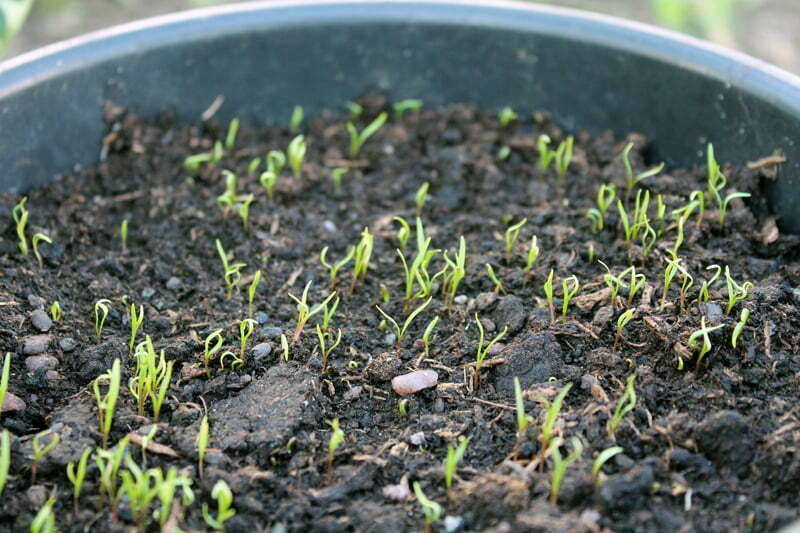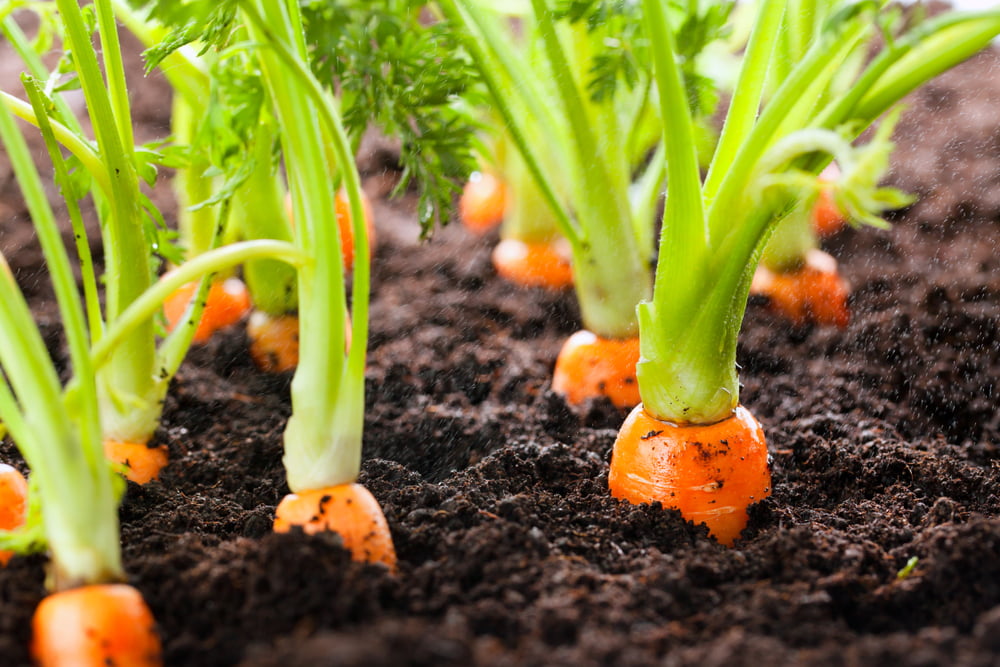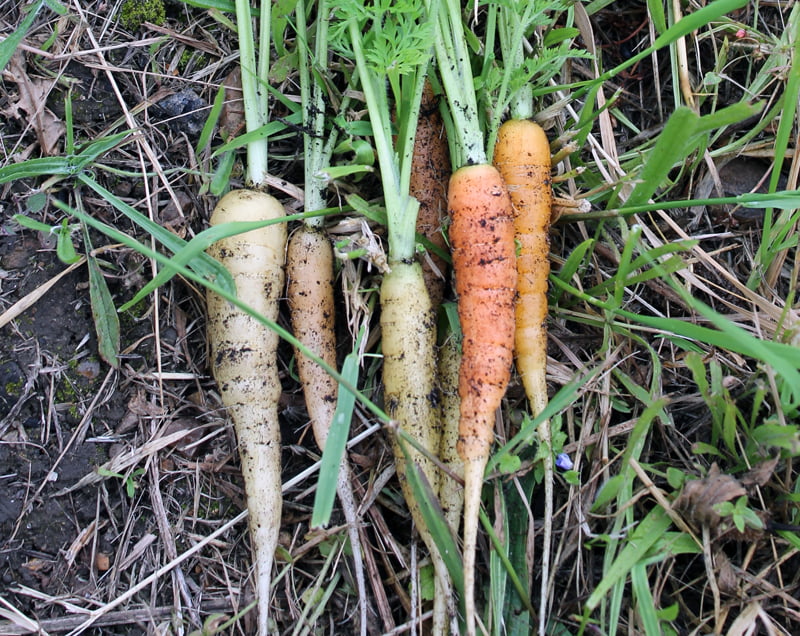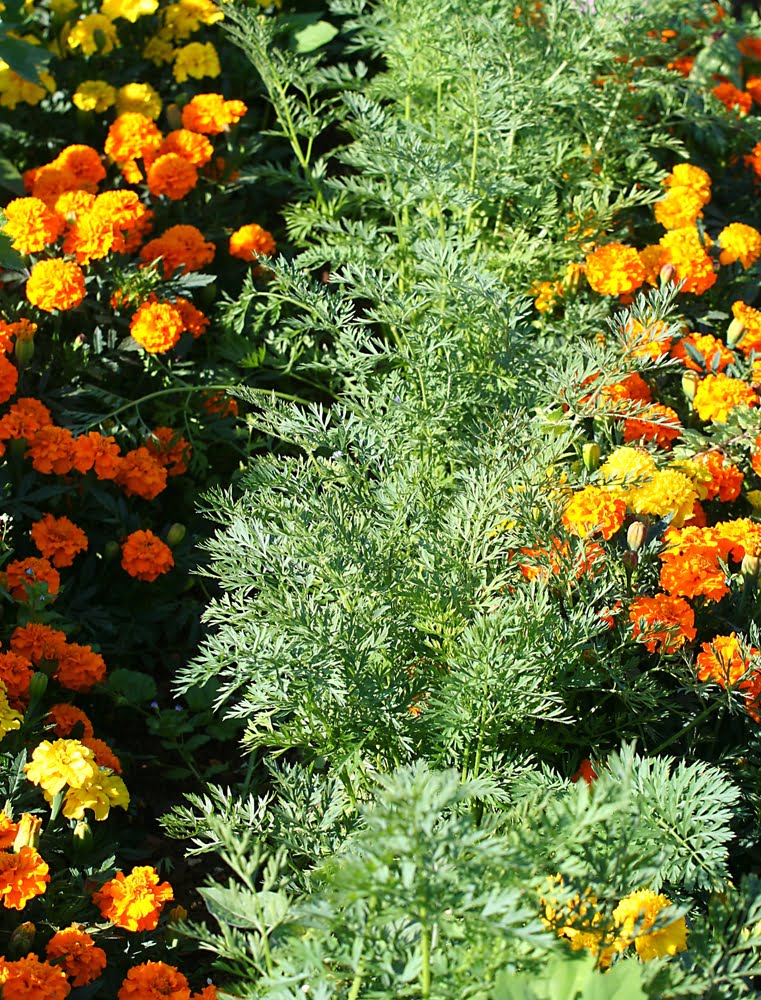In this Article
For a novice gardener, carrots can be surprisingly tricky to grow – these delicious root vegetables often fail to germinate, and those that do grow may be tiny, split, forked, or get eaten by garden pests. So, what is the secret to growing a bumper crop of crunchy carrots? Let’s find out!
Quick guide to growing carrots
Today we’re going to take a deep dive into every stage of the carrot growing process, from sowing right through to harvest. Our comprehensive guide includes some fantastic tips to guarantee a successful carrot harvest, even if you’ve tried and failed many times before.
To get you off to a great start, follow this quick step-by-step guide to growing carrots:
- Carrots grow best in loose, well-draining soil in full sun or partial shade.
- Prepare the soil by breaking up lumps and removing stones.
- Thinly sow carrot seeds in shallow trenches spaced 12 inches apart.
- Water gently every day until the seeds germinate.
- Thin out seedlings to 3 inches apart.
- Cover with fleece or fine mesh to deter pests.
- Water deeply one or twice weekly during dry periods.
- Harvest 2-3 months after sowing.
Growing carrots: Soil preparation
Carrots are root vegetables, which means the part that we eat grows below the surface of the soil. They grow by sending out a thin main root – the tap root – deep into the soil. Over time the tap root swells, forming a crisp, delicious carrot.
For optimum growth, carrots need loose, well-draining soil that allows the root to grow freely without obstruction. Remove any rocks and large stones from the soil, and rake it thoroughly to break up any large lumps. Digging can help to loosen the soil structure, but this also damages the beneficial network of microorganisms in the soil. Loosening the top few inches of soil should be sufficient for the roots to take hold and travel downwards.
Carrots can grow well in no-dig vegetable beds, but growth may be stunted during the first growing season if the soil is very compacted. Over time the soil will loosen as more organic matter is added, creating the perfect growing conditions for perfectly shaped carrots.

Do carrots like sun or shade when planting?
Most of the year round, carrots grow best in full sun but can cope with partial shade for some of the day. During the hotter months of the year – late spring and summer – it is better to grow carrots in a shadier spot to reduce the risk of bolting. Bolting occurs when carrots prematurely finish their growing cycle and start to flower, at which point the carrot root becomes tough and inedible.
How deep should the soil be for carrots?
Carrots have long tap roots and need at least 12 inches (30cm) of soil for successful growth. Larger carrot varieties will need up to twice this depth to allow the tap root to grow deep into the ground.
Carrots can be grown in containers and raised beds, but need a soil depth of 12 inches or more. When growing carrots in pots, opt for shorter varieties such as Chantenay, Oxheart, or Paris Market Atlas.

How much space do carrots need to grow?
Compared to many other vegetable crops, carrots can be grown relatively close together and you can get a reasonable harvest from a small vegetable bed or container. Up to 100 carrots can be grown per square metre of land, producing a yield of up to 10kg.
Growing carrots: Sowing seed & successful germination
One of the trickiest stages of growing carrots is germination. Carrot seeds are often sold as part of starter packs for children, which seems odd when even seasoned gardeners get frustrated about how hard it can be to get them to grow!
Carrot seeds are normally sown directly into their final growing position, as transplanting young seedling carrots risks damaging the delicate tap root. They germinate in soil temperatures from 7-29C (45-82F), with far faster germination in warmer soil. One common mistake many gardeners make is to sow carrot seed directly into cold soil in the spring, where it will rot before the weather warms up enough for germination to occur.
A great way to guarantee the successful germination of carrot seeds is to warm the soil by covering it in plastic sheets or cloches a week or two before the planned sowing date. This can raise soil temperatures by several degrees and can significantly extend the growing season in cooler regions of the UK. After sowing carrot seed, cover the ground with horticultural fleece for extra warmth.
What are the best carrots to grow?
One of the joys of growing carrots is the huge range of seeds available, including a range of different sizes and a whole rainbow of colours. Some are delicious when eaten raw, while others are more suited to cooking and can be canned or frozen. If carrot fly is known to be a problem in your area, opt for a carrot variety that is resistant to this troublesome pest.
Here are our top five carrot varieties to try:
- Autumn King – large orange carrots that are easy to grow and store well over the winter.
- Flyaway F1 – specially bred for resistance to carrot root fly.
- Red Samurai F1 – smooth red carrots with pink flesh.
- Rainbow – produces carrots in a range of shades from orange to white.
- Chantenay Red Core – full-flavoured crisp carrots, perfect for salads and crudites.
What is the best month to sow carrots?
Carrots can be grown almost all year round, but accurate timing is essential to guarantee successful germination. In the UK, early varieties are sown in February or March, but the soil will need to be warmed with cloches or fleece. Maincrop carrot varieties are sown from April to early July. In warmer regions, carrots can be sown again in early autumn for a late winter/early spring harvest. Sowing carrots every 2-4 weeks ensures a continuous harvest throughout the year.

How many carrot seeds do you plant per hole?
Carrot seeds are sown directly into a shallow trench – around ½ inch deep is sufficient. The seeds are tiny so accurate spacing can be difficult, but sprinkle them as thinly as you can. As germination rates can be poor, there is no harm in sowing extra seed as any surplus seedlings can be thinned at a later date. If you struggle with spacing out carrot seeds, consider using biodegradable seed tape instead.
Carrots can be slow to germinate, taking up to three weeks to make an appearance. It is a good idea to mark the rows with string to avoid accidentally disturbing or standing on the seed bed. Fast-growing radishes can be sown in between rows of carrots to maximise the use of space and protect the soil and young seedlings.
Once the carrot seedlings are around an inch tall, you will need to thin out any surplus to leave the strongest plants three inches apart. Rather than pulling out unwanted carrots, pinch these tiny seedlings off at soil level with your fingers to avoid disturbing the soil.
Don’t panic if you didn’t manage to thin out your carrot seedlings when they were small, as this can be done at a later stage too. Carefully pull out surplus carrot plants, taking care to disturb the soil as little as possible. These carrot thinnings may even be large enough to eat, but the flavour will not be as fully developed as a mature carrot root.
Growing carrots: Watering
When growing carrots from seed, the soil should be kept moist until germination occurs. Daily watering may be necessary during warmer periods, and it is a good idea to cover the seed bed with fleece to reduce moisture evaporation and wind chill. Remember that sandy soil dries out easily, and will require watering more frequently.
How often do you water carrots?
The aim when growing carrots is to encourage the tap root to extend deep down into the ground in search of moisture. Once the seedlings are well established, soak the ground once or twice every week, allowing the top inch or so of soil to dry out between each watering. During the hottest summer months consider mulching the soil surface to help retain moisture and reduce the risk of bolting. Carrots grown in containers will need watering more frequently as they are prone to drying out.
Growing carrots: Fertilisation
Carrots have very low nutrient requirements and will grow abnormally if extra fertiliser is added to the soil. Ideally, carrots should be grown in beds that were amended with organic matter the previous year. Soil that is too nutrient-rich will lead to forking, where the main root branches into several smaller sections.
Growing carrots: Pest control
In the UK, the main issue that affects homegrown carrots is the carrot fly. The larvae of this prolific pest tunnel into the roots of carrots, causing damage that may go unnoticed until harvest time. In some cases, this damage may purely be cosmetic, and the damaged parts can be cut away. However, severe infestations of carrot fly can render the entire yield inedible.

Carrot crops can be covered with fine mesh or fleece to prevent carrot fly attacks. Alternatively, sow onions or other alliums in between rows of carrots – their strong scent is thought to confuse the carrot root fly, acting as a deterrent. Homemade garlic spray can also be effective but will need to be reapplied frequently. Interestingly, carrots grown in containers and raised beds are less susceptible to carrot fly, as the flies travel close to the ground.
Growing carrots: Weeding
Carrots have very fine foliage that struggles to compete with weeds. However, weeding carrots can be tricky, as it is all too easy to accidentally damage or pull up your young plants. The roots of carrots are very sensitive to disturbance, adding a further level of difficulty to weeding.
The best way to weed carrots is to gently pinch out any weed seedling as they emerge. If they become too large for hand weeding, cut them down at soil level and apply a layer of mulch to suppress further growth.
Growing carrots: Harvesting
Carrots are harvested by pulling gently on the base of the stems. If the soil is soft and crumbly, the carrot should slide easily out of the ground. Larger carrots may require slightly more force to prise them out of the ground, particularly in heavy clay soil that is hard and compacted.
If your carrots are proving difficult to pull up, they can be gently levered out of the ground with a spade. Push a garden fork into the ground inches away from the carrot roots to avoid damaging them, then pull the for back up. You should then be able to carefully pull the carrots out of the ground.
How long for carrots to grow?
The length of time carrots take to grow will depend on what time of year they were sown. Carrot seeds sown directly into warm soil in the spring can be ready to harvest in as little as two months. Cooler weather slows down carrot seed growth rates, and overwintered carrots may take twice as long to reach maturity. Carrots sown in the summer grow rapidly but are prone to premature bolting.
When to harvest carrots?
Knowing when to harvest carrots can be tricky – you may see a pleasing abundance of lush foliage above the ground, but the roots below could still be tiny! To determine if and when your carrot plants are ready to harvest, gently push a finger into the soil at the base of the plant. You should be able to feel the top of the carrot, helping you to decide if it has reached the required width for harvesting. Of course, you have no way of knowing how long it is until you pull it up, but hopefully, you will be pleasantly surprised!

